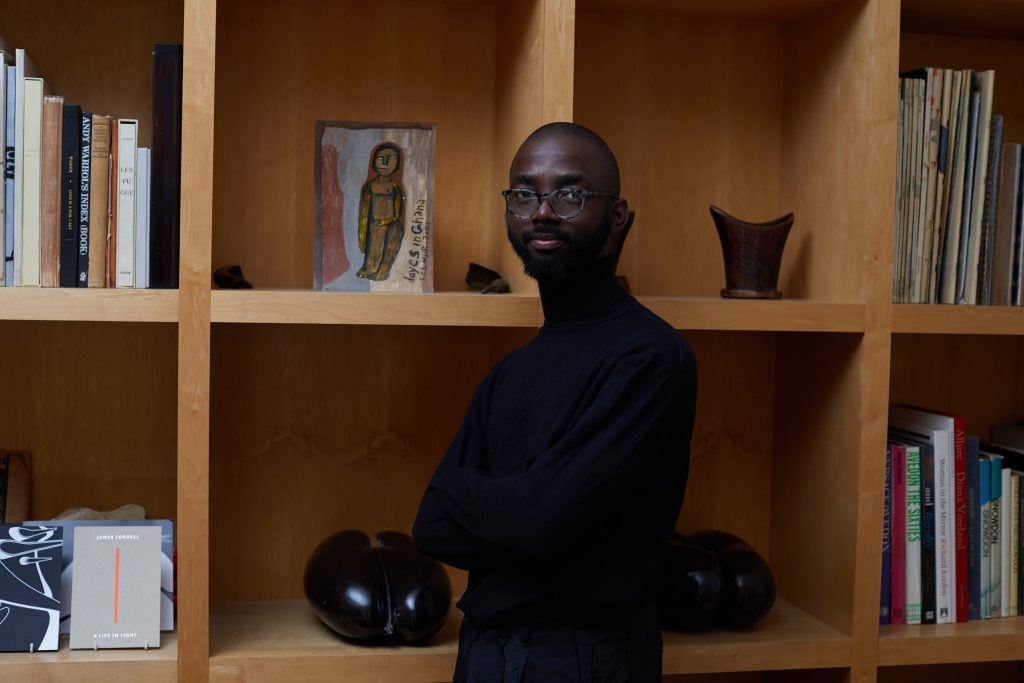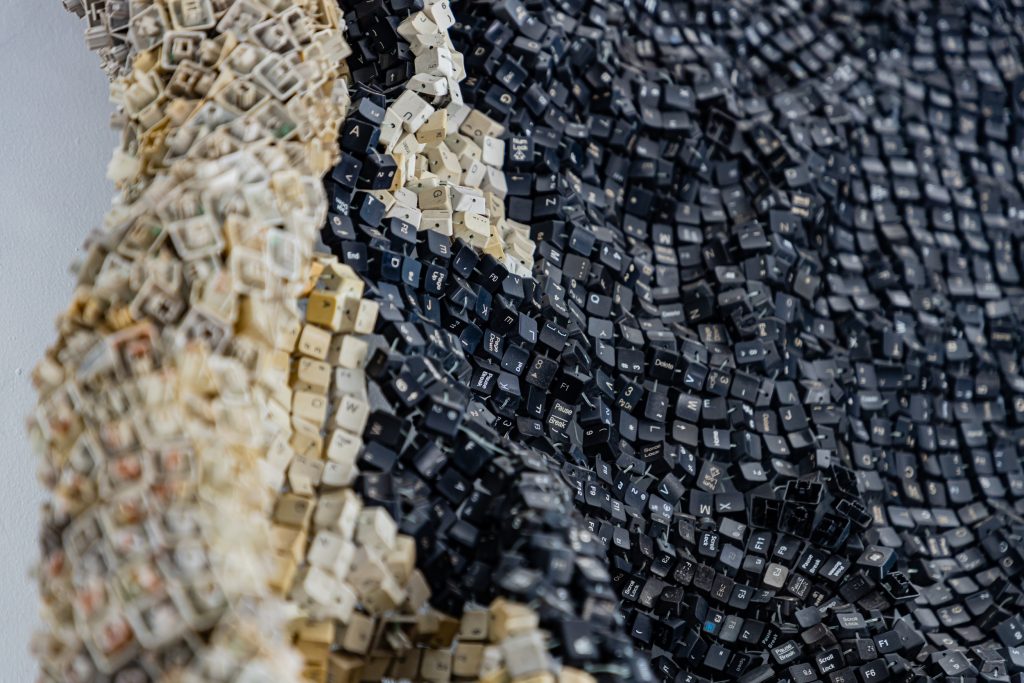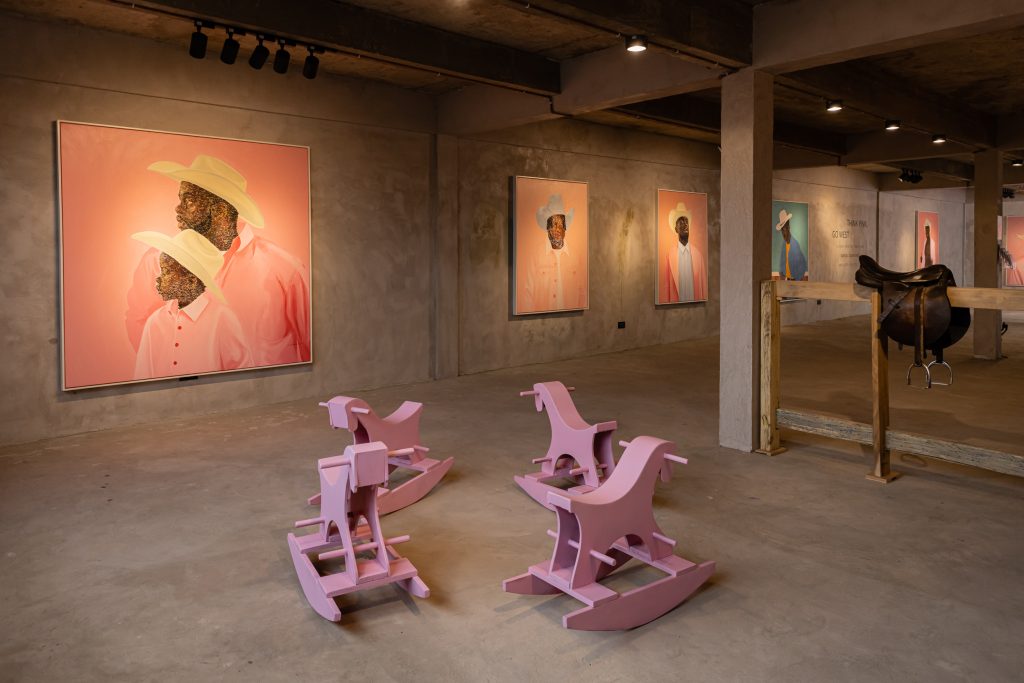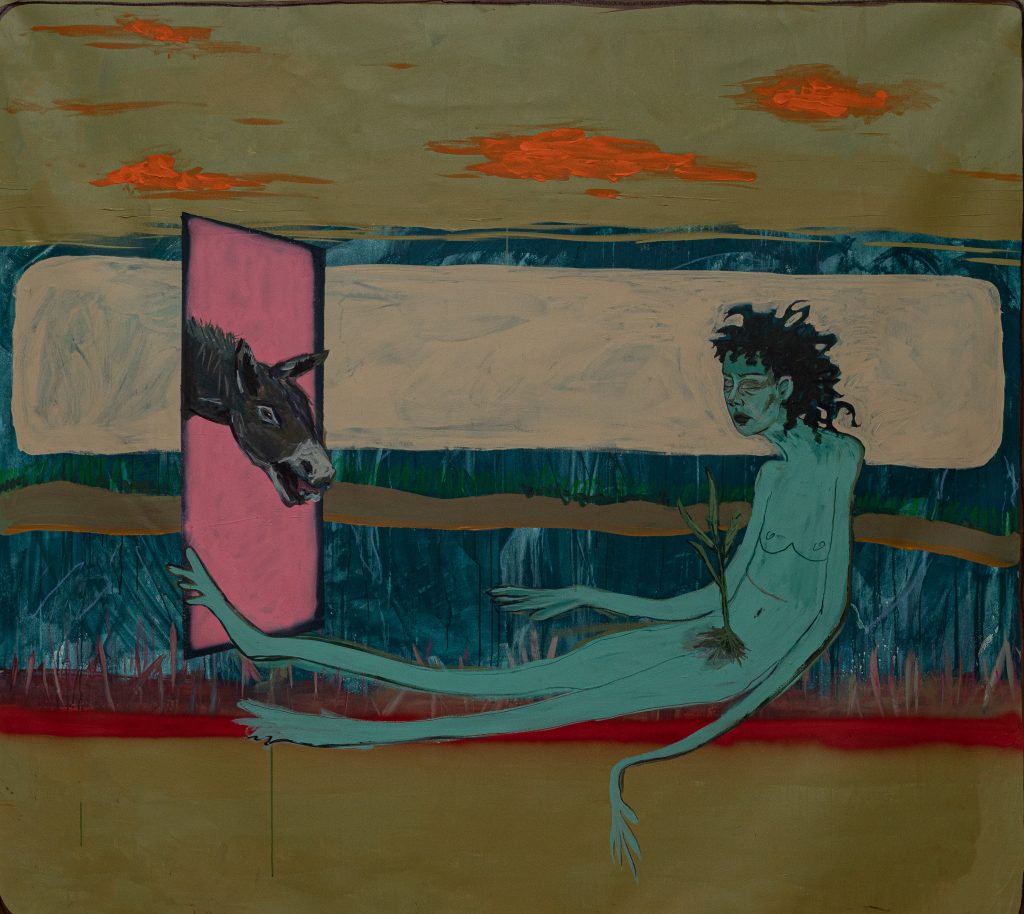Up Next
Multi-Hyphenate Joseph Awuah-Darko on the Rise of Africa’s Art Market
Ghanaian polymath Joseph Awuah-Darko discusses Accra's art scene, what he collects, and why painters are moving away from figuration.

Ghanaian polymath Joseph Awuah-Darko discusses Accra's art scene, what he collects, and why painters are moving away from figuration.

Holly Black

At the age of 27, Ghanaian collector Joseph Awuah-Darko already has many strings to his bow. He is also a practicing artist, musician, writer, curator and entrepreneur, and his self-described “precocious attitude” has helped him pushed the envelope of what it means to be a patron of the arts in the nascent and decidedly grassroots art scene of Accra. Among the new generation of African collectors on the continent, he is a leading figure that bridges disciplines and demographics.
“I’ll be the first to admit, I don’t come from a family that collects art,” Awuah-Darko said. “I was something of an outsider.” Born in London in 1996, to an influential family of Ghanaian financiers, he relocated to Africa with his parents when he was a child and now lives and works in Accra, while also maintaining a home in the British capital.
A defining moment that set him on his path to joining the art world happened while he was studying at Ashesi University, in Accra, in 2016. The award-winning Belgian-Beninese photographer Fabrice Monteiro paid a visit to the school, seeking volunteers to assist in one of his elaborate photoshoots at Agbogbloshie—once the largest e-waste dump in Africa—where he repurposed discarded electronics into high fashion concepts. “I was very, very keen to be involved,” Awuah-Darko said. “That was the start of my journey into creating work in the art world.”

A detail of the tapestry Chief Justice (2018) by Zimbabwean artist Moffat Takadiwa, made from discarded computer keys, from Joseph Awuah-Darko’s private collection. Courtesy of the Institute Museum of Ghana.
The experience led him to set up the Agbogblo.Shine Initiative a year later. This enterprise turns discarded electronics into high-end furniture, while offering training to scrapyard workers to promote safety and new forms of craftsmanship. Awuah-Darko also created a series of sculptures born from the dump’s detritus, which were shown at Gallery 1957’s space in Accra in 2019. It is no wonder he is drawn to the work of artists who show a similar dedication to circular economy and social change, including Attukwei Clottey, Ibrahim Mahama, and Moffat Takadiwa.
In fact, Awuah-Darko’s position as a reigning tastemaker within Accra’s art ecosystem has grown organically through his friendships with other artists. This has also led him to build a collection rich in the works of Ghanaian art stars, such as Serge Attukwei Clottey and Gideon Appah. His influence has also garnered attention on the wider world stage, including a name-check in Forbes Africa’s “30 Under 30” list in 2019, where he was celebrated both as an artist and the managing director of the African Modern Art Fund.
In 2020, Awuah-Darko embarked on his biggest project yet: founding the Noldor Residency and Museum Institute of Ghana, housed in an old pharmaceutical factory in Accra’s seaside neighborhood of Labadi. This initiative supports emerging artists from the African continent and its diaspora with studio space and exhibitions, as well as inviting more established individuals on a range of fellowships.
“I really want African artists to be able to create work and build careers without ever having to travel abroad,” Awuah-Darko explained, which is no mean feat considering the complete lack of public funding for the visual arts in Ghana. “When we think of amazing artists such as Amoako Boafo and Otis Kwame Kye Quaicoe, there is a sense that they had to become diasporan to further their careers, before coming back.”

Installation view of “Think Pink, Go West” by Noldor alumnus Samuel Olayombo at the Institute Museum of Ghana (March 24–June 24, 2023). Courtesy of the Institute Museum of Ghana.
The residency was inspired in part by the legacy of Peggy Guggenheim, who Awuah-Darko said “supported artists in a very unique and meaningful way.” He sees this as being a conduit that connects artists with galleries and cultivates opportunities, to help further their careers. Among the success stories, he points to Noldor alumni such as Maku Azu, who has exhibited at Peres Projects in Berlin, and Youssra Raouchi, who has been shortlisted for the 2024 Norval Sovereign African Art Prize.
Today, Awuah-Darko is one of the most active members of a wider network of artists and innovators who are creating the change they want to see in the city. “Labadi has really become something of an arts district now,” he explained. “We have Serge Attukwei Clottey’s incredible studio, Ablade Glover’s Artists Alliance Gallery, Amoako Boafo’s dot.ateliers, the Dikan Center, which is one of the largest photography libraries in Africa—the list goes on!”
Despite the success of these artist-run initiatives, contemporary art collecting is still at an embryonic stage in Ghana, Awuah-Darko added. “On the continent, very few people collect African art on the scale that it is done in the west, with the unique exception of Nigeria, which has a very big collecting class along with art fairs such as Art X Lagos,” he explained. “I’d say I’m one of the only Ghanaians living in and collecting in Ghana—but that is starting to change.”

A fashion show by Ajabeng held at the pavilion courtyard of the Noldor Residency, founded by Awuah-Darko in 2020. Courtesy of the Institute Museum of Ghana.
A positive force when it comes to democratizing and demystifying the process of buying art is the proliferation of art marketplace apps, Awuah-Darko said, which “can be really transparent regarding price points and budget ranges.” He also praised the power of Instagram, which he said was invaluable when he was starting out. “Social media is a powerful tool when it comes to discovering artists. You can get a sense of a body of work, or a creative trajectory, very quickly.”
While the digital sphere has certainly aided his networking and research, Awuah-Darko professed that nothing beats an in-person studio visit. “It is one of the most enriching parts of being a collector,” he said. “I’ve been to studios in Paris, Dakar, Amsterdam and Lagos, and my dream would be to do some sort of roadshow, where I could conduct a series of visits and discussions which could be broadcast.”
On entering the new year, Awuah-Darko is taking time to reevaluate his collection and plans to focus on gender parity and more textile-based pieces, as well as works on paper. “A lot of glory is given to works on canvas, but drawing is really the genesis of any remarkable idea,” he said. In terms of his latest acquisitions, a favorite is a sculpture by Senegalese ceramicist Seyni Awa Camara, which features a siren. Her totemic terracotta pieces were show in dialogue with paintings by the Kenyan-born British artist Michael Armitage at White Cube in London in 2022.

Walk In Gardens (2023) by Youssra Raouchi, an alumna of the Noldor Residency who has been shortlisted for the 2024 Norval Sovereign African Art Prize. Courtesy of the Institute Museum of Ghana.
Awuah-Darko also predicts a move away from the dominance of figurative painting. “It has had a really explosive moment over the past few years and I think there will be something of a correction,” he said. “There have been a lot of artists playing the imitation game, which had led to a saturation of this kind of work. Collectors aren’t mindless. The work really needs to speak to more than just bodies on bodies, or a Black person painting another Black person. It has to move beyond that.”
With all this activity, Awuah-Darko sees his chosen home city as poised to become a bigger hub. “Accra is going through a period of awakening and resurgence,” he said. “The blossoming of residency programs and artist-led initiatives is creating an environment with the capacity for collecting to happen.”